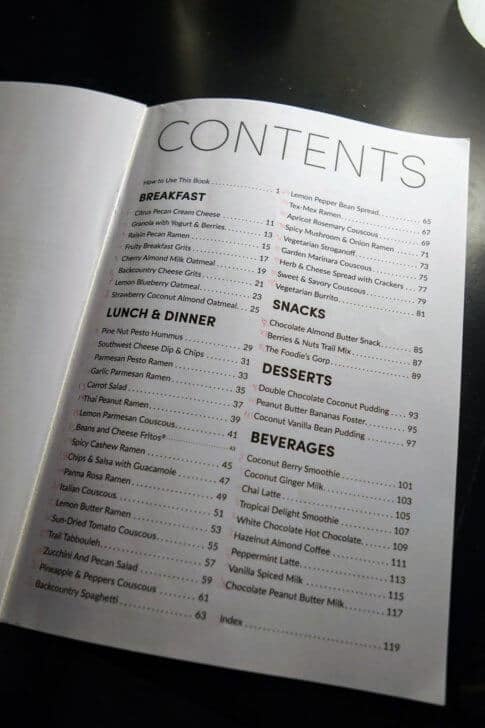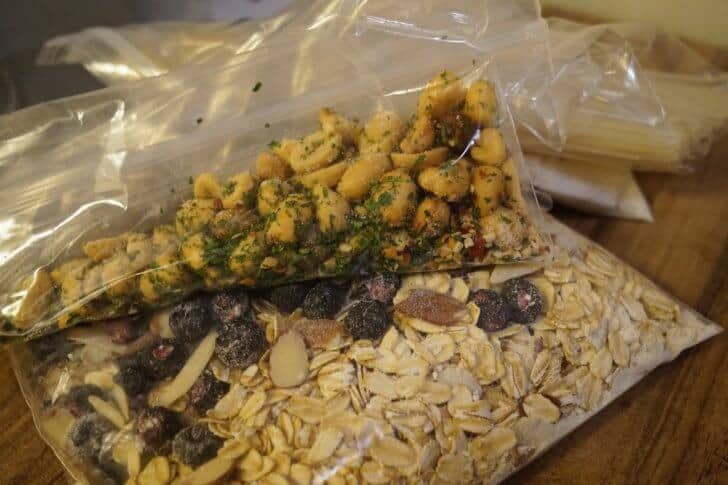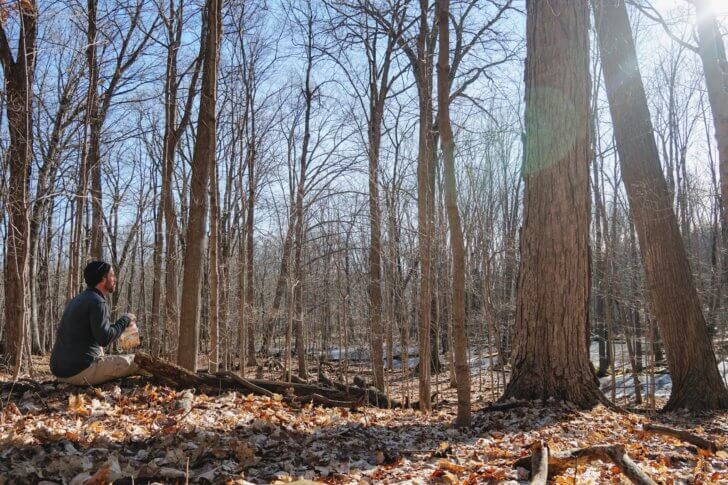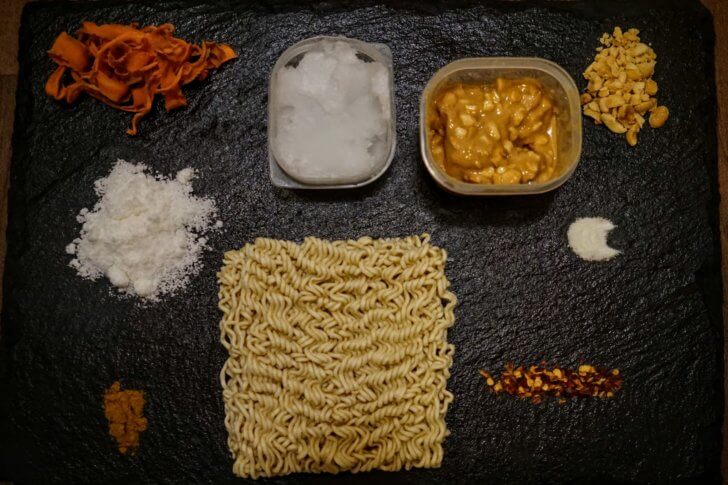Introduction
Backcountry Foodie – Ultralight Recipes for Outdoor Explorers by Aaron Owens Mayhew, MS, RDN, CD. is a cookbook containing 50 dry-based ingredient recipes along with detailed nutritional information for each. The target audience is backcountry adventurers looking to expand their dining options, drop some consumable weight, save money over pre-packaged meals, and those concerned with their nutritional intake.
The book provides unique recipes with both “at home” and “in the field” instructions. It also provides enough detailed nutritional information to allow for proper meal planning for multi-day trips. Finally, downloadable label files are available for each recipe to aid in keeping track of the meals while on the go.

Features
- 50 recipes ranging from 128 – 182 kcal/oz
- Gluten-free* recipes and options
- Vegetarian and vegan recipes and options
- Nut-free* recipes
- Recipes costing less than $3.00 per serving
- Dry ingredient based recipes which can be assembled in under 5 minutes
- Printable food label sticker templates.
- Only digital copies currently available
* Trace amounts of nuts and gluten may be present in the raw ingredients
Review Context
I am a longtime oatmeal-and-trail mix, barebones, ultralight backpacker who is looking to expand my backcountry kitchen toolkit. Generally, my trips are two or three days in length with the occasional week-long trek thrown in. In my non-backpacking life, I have high standards for food, particularly as I spent a decade working professionally in Chicago kitchens.
In evaluating this cookbook, I considered:
- Recipes – A recipe should be straightforward, easy to follow, and contain ingredients that are simple to source.
- Organization – Recipes should be easily found and appropriately grouped by meal or some other logical categorization.
- Ease of use – Is the format simple to understand with any necessary information readily available?
When creating a meal plan, I believe an ultralight backpacker should consider:
- Kcal/oz – The food needs to be calorie-dense and lightweight.
- Nutritional value – I feel better when I eat better; my recovery is faster and I can log more miles.
- Convenience – From ingredient sourcing through clean up, less time working on meal preparation is more time spent hiking or enjoying the scenery.
- Taste – A backcountry meal is more than just fuel. It can provide a much-needed pick-me-up and add enjoyment to the end of a long day. It should taste good!
Description of Field Testing
Upon receiving the cookbook, I began collecting ingredients and working through the recipes, initially testing them in my home kitchen. After testing at home, I selected seven recipes for field testing: two from the Breakfast section, two from the Lunch & Dinner Section, one Snack, and two Beverages. My selections included both cook and no-cook options.
Field testing of the recipes took place under winter conditions in southeast Michigan. Temperatures ranged from daytime highs around 45F to morning lows in the high 20s. There was little-to-no precipitation. During weekend hikes I would alternate days of cold meal preparation with hot meal preparation using an alcohol stove. I treated the final weekend of testing as a tune-up for a planned Isle Royale National Park speed hike, allowing me to note my impressions of energy levels after logging 10+ mile days on my feet.
Performance Assessment
I based my performance assessment of Backcountry Foodie – Ultralight Recipes for Outdoor Explorers on the following criteria:
- Cookbook organization
- Cookbook ease of use
- Recipe convenience
- Taste
- Impressions of energy level and nutrition
For the evaluation of the recipes themselves, I’ll focus on the seven recipes I field-tested over my shakedown weekend. My no-cook day consisted of a breakfast of Raisin Pecan Ramen and an afternoon meal of Lemon Pepper Bean Spread. My evening treat was Coconut Ginger Milk. For my cook day, I prepared a breakfast of Lemon Blueberry Oatmeal and an afternoon meal of Thai Peanut Ramen. In the evening I treated myself to a decaf Peppermint Latte. On both days I supplemented with a Chocolate Almond Butter snack while walking.
Cookbook organization
Backcountry Foodie – Ultralight Recipes for Outdoor Explorers is a well-organized cookbook. It starts with a brief section detailing how to use the book, followed by recipes broken out by meal and food type as follows:
- Breakfast
- Lunch & Dinner
- Snacks
- Desserts
- Beverages

Cookbook ease of use
I found the cookbook easy to use. Each recipe fits on a single page and contains a list of ingredients, at home directions, field directions, nutritional information, and summary information. The summary information proved to be very helpful in meal planning, providing ‘At a Glance’ information regarding preparation method, potential allergens, vegan/vegetarian information as well as preparation and cooking time, the number of servings created, and the weight per serving. When used in tandem with the nutritional information, it was very easy to meal plan for my weekend hikes.

Recipe Convenience
Generally speaking, the recipes are very convenient. Both at-home and in-the-field meal prep were straightforward with no hiccups. I was able to complete the at-home portion of meal prep in under two minutes per-meal. My cold-soaking days went off without a hitch. All of the ingredients rehydrated well without any additional heat. Similarly, I had no issues with the recipes that needed cooking (I used an alcohol stove). The biggest hurdle I faced throughout the entire process was sourcing the ingredients.

Even though I live in a large city, I had trouble sourcing a number of the ingredients locally. I spent an afternoon traveling from grocery to natural food store to camping supply company to another supermarket. The author does provide online sources for ingredients via links on her website, and I could have saved myself some trouble by sourcing online. If you are under a time crunch, as I was, you might have to use ingredient substitutions.
The book lists the recipes in cups, tablespoons, and teaspoons. With an intended audience that likely weighs their toilet paper for fun, providing weights for the individual ingredients (to allow for scale measurement when assembling the recipe) would have been a nice touch. I found that my weight for the completed Lemon Blueberry Oatmeal was a couple of ounces higher than the listed weight. Using a scale to measure out ingredients makes for more repeatable recipes and ensures that the weights are dialed-in with precision.
Taste
Taste is subjective, but I found these recipes to be delicious. Many of the recommended ingredients were ones I’d not used before. I found they added enjoyment and variety to my outdoor dining experience. Coconut milk powder is a fantastic ingredient that I wish I had known about back in my pastry chef days. Same with True Lime Powder, which added a burst of flavor to the Thai Peanut Ramen. None of the recipes I tested were duds.

Impressions of energy level and nutrition
The layout of Backcountry Foodie – Ultralight Recipes for Outdoor Explorers lends itself well to caloric analysis. On both my no-cook and cooking days, I was able to consume over 3000 calories. My intake of protein, fats, and carbohydrates was well balanced. My energy levels were high and seemed consistent throughout the day.
Product Strengths
- The format and layout of the cookbook contribute to painless meal planning and easy backcountry cooking.
- The author balanced the flavors in her recipes. She uses spices, sweets, and acids skillfully, creating dishes that were a pleasure to test. Nothing that I tested (or tasted) was bland.
- The provided nutritional information and easy-to-interpret sidebar graphics help ensure adequate caloric intake.
- Once I started measuring out the recipes, I realized how much less expensive it is to create my meals as opposed to buying freeze-dried, pre-packaged offerings.
Product Limitations
- I wish that the ingredient lists had measurements listed in grams or ounces.
- While the author provides online sources for all the ingredients she uses in Backcountry Foodie – Ultralight Recipes for Outdoor Explorers, I found myself wishing that more of the items were available at my average mid-western supermarket.
Compared To Your Typical Ramen and GORP
Overall the recipes from Backcountry Foodie – Ultralight Recipes for Outdoor Explorers outperformed my usual backpacking diet of oatmeal pouches for breakfast, GORP for lunch, and ramen for dinner. My old standbys win if I am judging the basis of convenience; there is not much easier than tossing a few bags in my kit and calling it good. There is something to be said for variety, though. Aaron’s recipes introduced me to ingredients I had never considered using in backpacking food. The change was welcome on the basis of taste alone.
I felt better physically after eating Aaron’s food. An afternoon meal of GORP and water sits pretty heavy in the stomach, particularly on the third or fourth day in the field. It seemed to me that I was better able to get back to hiking after eating the afternoon meals of Lemon Pepper Bean Spread or Thai Peanut Ramen.
Commentary
Even though I have over ten years experience in the professional kitchens of Chicago and scores of backpacking miles under my belt, as I flipped through the pages of Backcountry Foodie – Ultralight Recipes for Outdoor Explorers, it dawned on me that I was really missing out on a cheap, easy way to enhance my enjoyment while spending time outdoors. It also occurred to me that my old standbys were somewhat lacking in complete nutrition.

I honed my outdoor culinary chops during my time with the Boy Scouts, and my backpacking menu was an old and familiar one. The pack list was simple. Packaged oatmeal for breakfast, trail mix and beef jerky for lunch, and a pre-packaged freeze-dried meal for dinner.
As the years have gone on the menu hasn’t changed much. Beef jerky left the pack list when I became a vegetarian. I added coffee to my breakfast and replaced the expensive freeze-dried meals with cheap ramen and bouillon. It was a bland backcountry diet. Working through the cookbook, it became clear how easy it can be to add new recipes to the rotation that won’t sacrifice convenience, cost a fortune, and will taste great.
The Thai Peanut Ramen recipe is a great example of the quick and easy steps Aaron has laid out in her book.
- Step one: I make certain I have all the ingredients on hand. Some of the ingredients are hard to find at your local corner store, so plan accordingly or be prepared to make substitutions.
- Step two: I grab any tools I’m going to need. For Aaron’s recipes, the list of tools is blissfully simple; storage containers and measuring spoons. I mentioned earlier that I wish the book had weights for each ingredient listed, but I admit it is much faster to build out a recipe when you are simply scooping out the parts.
- Step three: pack it all up. Put the ramen noodles and dehydrated carrots in a bag, measure the other dry ingredients in a separate bag and measure out some peanut butter and some coconut oil. That’s it. For longer trips, I would simply just bring a bunch of peanut butter in one container and use it across multiple meals. I might do the same with the coconut oil as well, though I might substitute olive oil as I find it to be more versatile.

I found Backcountry Foodie – Ultralight Recipes for Outdoor Explorers to be a fantastic resource. The individual recipes stand stand up well. They are simple to prepare, nutritious, and filling. Every recipe I tried was quite tasty. However, the greatest strength of the book is the nutritional information which allows readers to build their own nutritional, balanced meal plan for their outdoor adventures.
Where to Buy
- You can find digital copies of Backcountry Foodie – Ultralight Recipes for Outdoor Explorers here. The paper copy is currently out of stock, but we will be sure to update as more become available.
Related Content
- Have you listened to the Food and Nutrition episode of the Backpacking Light Podcast?
- George Harris used an alcohol stove to prepare his meals for this review. New to alcohol stoves? This is a useful thread from our forum.
Disclosure
- How we acquired these products: Product(s) discussed in this review were either acquired by the author from a retailer or otherwise provided by the manufacturer at a discount/donation with no obligation to provide media coverage or a product review to the manufacturer(s).
- We do not accept money or in-kind compensation for guaranteed media coverage: Backpacking Light does not accept compensation or donated product in exchange for guaranteed media placement or product review coverage.
- Affiliate links: Some (but not all) of the links in this review may be “affiliate” links, which means if you click on a link to one of our affiliate partners (usually a retailer site), and subsequently make a purchase with that retailer, we receive a small commission. This helps us fund our editorial projects, podcasts, instructional webinars, and more, and we appreciate it a lot! Thank you for supporting Backpacking Light!



Home › Forums › Book Review – Ultralight Recipes for Outdoor Explorers